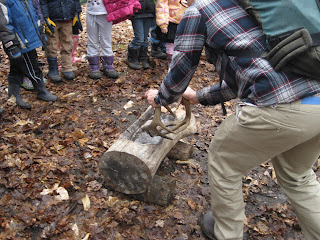On this very warm Thursday I went to the Green Mountain Audubon Center in Huntington, VT with the young gentleman and his class. The kids learned all about maple sugaring.
Our guide, Daniel, taught us that there are two parts to sap that we collect from sugar maple trees: sugar and water. To be more specific: A LOT of water and a little sugar. The water is boiled off in an evaporator so that we're left with the sweet, sweet syrup. It takes about 40 gallons of sap to make 1 gallon of maple syrup.
Looking at the evaporator and all the sweet-smelling steam boiling off
He showed us how they skim off the leaves and bits of other things found in nature that wind up in the sap (but we don't want in the final syrup). Then we got to see how they test the syrup as it boils. He had a hygrometer, which looked a lot like a thermometer with a large, hollow glass bulb at the bottom. If the hygometer sinks to the bottom, then the syrup is too watery. If it floats, the syrup is too thick. They are looking for it to settle halfway in the syrup.
This syrup still needed time to boil off water (the hygrometer sank)
Then we got to taste different grades of syrup. Fancy, medium amber, dark, and grade B. Did you know that different grades are collected at different times of year and under different weather conditions? And it doesn't progress strictly as they year progresses, they can collect medium, then dark, and then back to medium!
Syrup tasting, yum!
(See the American beech in that picture, with its leaves still clinging on at the end of the winter? The young gentleman did, and told one of his friends why it was a beech. That tree surely stuck in his mind from way back when.)
Then we got to see Daniel tap an actual tree! Right down to drilling the hole with his hand drill. It was really cool that even the wood shavings coming off the drill had a drop of sap you could squeeze out. We could tell if a tree was ready to tap because if you can reach all the way around it and touch your hands, that tree is too small. If two friends can reach around it, that tree is ready for one tap. If three friends, then two taps and so on.
This tree was barely too big for the young gentleman and one friend,
but the third friend closed the gap. I'd put two taps in this tree.
Daniel had showed us an example of the lines that they sometimes use to collect sap. The sap drips from the tree, flows down the line, and straight to the sugar house. But here at the Audubon they use buckets and haul the sap in manually. This is the method we used when my family made syrup when I was a kid :) The children ran around collecting buckets from the trees, till we had a good amount of sap. After Daniel told us the story of how maple syrup was first discovered, he demonstrated the traditional method of syrup-making with the sap we collected! He placed the sap in a hollowed-out log, and then added hot rocks he pulled straight from the fire. He used deer antlers to transport the rocks.
With all the rocks in (and a friend blowing away the steam)
The set-up (he removed the rocks since this was only a demonstration)









is it revealing a Vermont secret to point out that Grade B is actually the yummiest syrup?
ReplyDeleteWow, this is delightful! That looks like so much fun!
ReplyDelete